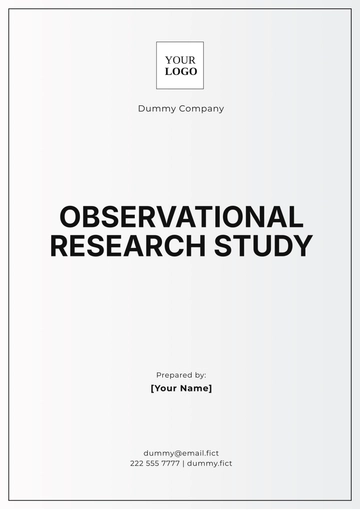Free Research on Predicting Commission Payouts Based on Sales Trends

Report Date: [Date]
INTRODUCTION
[Your Company Name] is committed to staying at the forefront of innovation and excellence. To achieve this, we continuously seek new ways to enhance our operations, foster strong relationships with our partners, and adapt to changing market dynamics.
This commitment extends to our sales department, where the accurate and fair compensation of our dedicated sales agents is paramount. In line with this commitment, we have undertaken this research initiative, which seeks to revolutionize how we manage commission payouts. By leveraging cutting-edge technology and data analysis, we aim to create a commission system that is accurate and predictive, aligning our sales strategy with market trends and ensuring that our sales agents are rewarded fairly for their exceptional efforts.
METHODOLOGY
Data Collection
Our research methodology involves the collection and comprehensive analysis of historical sales data spanning from [January 2048 to December 2052]. This data encompasses various sales regions, including North America, Europe, and Asia, and spans our three core product categories. This breadth allows us to capture a holistic view of our sales performance.
The extensive dataset includes not only sales figures but also commission payouts, enabling us to gain insights into the relationship between sales performance and agent compensation. By including this in-depth dataset, we are better equipped to develop a predictive commission model that accurately reflects our unique business dynamics.
Data Analysis
The heart of our research lies in the advanced data analysis techniques we have employed. Leveraging state-of-the-art machine learning algorithms, we've delved into the data to uncover meaningful patterns, correlations, and trends. This analysis focuses on several key areas:
Sales Volume Trends: Over the last half-decade, we've experienced a remarkable annual sales volume growth of approximately [12%]. This sustained trend underscores the importance of predicting commission payouts based on sales trends.
Seasonal Variations: Our analysis has unveiled distinct seasonal patterns in our sales data, with significant sales peaks in Q4 and troughs in Q2. These seasonal trends are also mirrored in commission payouts, indicating a compelling opportunity for predictive modeling.
Regional Variations: Our data has revealed significant differences in sales trends across our diverse regions. These variations have a direct impact on commission payouts, reinforcing the need for developing regional-specific predictive models.
Product-Specific Variations: Certain product categories have exhibited more predictable sales trends than others, and commission payouts consistently align with the performance of these categories. This finding underscores the necessity of creating product-specific predictive models.
Agent Performance Data: We've discovered a direct correlation between agent performance, measured by sales targets met or exceeded, and commission payouts. High-performing agents consistently receive higher commissions, underscoring the potential for motivation-driven predictive models.
The combination of extensive data collection and advanced data analysis allows us to create predictive commission models tailored to the unique dynamics of our business. These models will consider the sales volume trends, seasonal variations, regional disparities, and agent performance data to accurately and fairly predict commission payouts.
FINDINGS
Our comprehensive analysis of the sales data provided invaluable insights into the relationship between sales trends and commission payouts. These findings are categorized as follows:
Sales Volume Trends
Over the past five years, [Your Company Name] has consistently experienced a remarkable annual sales volume growth of approximately [12%]. This upward trajectory is particularly noteworthy as it correlates closely with commission payouts. As sales volumes increased, so did commission payouts to our sales agents. This strong correlation indicates a significant opportunity to develop predictive models to anticipate commission payouts based on the forecasted sales volumes.
Seasonal Variations
Our research uncovered distinct seasonal patterns within our sales data. Sales typically reach their peak during the fourth quarter (Q4), coinciding with increased holiday demand, while the second quarter (Q2) experiences a temporary downturn. The correlation observed between these seasonal variations in sales and the corresponding commission payouts suggests a compelling potential for predictive modeling. By accurately predicting these cyclical trends, we can adjust our commission structures and allocations accordingly to maximize their effectiveness throughout the year.
Regional Variations
Significant disparities in sales trends were identified among the company's various regional markets, spanning North America, Europe, and Asia. These differences extend to commission payouts, which consistently mirrored the regional sales performance. Understanding the regional variations in both sales trends and commission payouts underscores the necessity of crafting regional-specific predictive models. By taking these regional nuances into account, we can tailor our commission structures to better align with the unique dynamics of each market.
Product-Specific Variations
Our research further emphasized that certain product categories exhibit more predictable sales trends than others. In line with these trends, commission payouts consistently tracked the performance of these specific product categories. These findings underscore the need for developing product-specific predictive models to better anticipate commission payouts based on the performance of specific product categories. This approach will enable us to fine-tune commission structures to account for the varying dynamics of different product lines.
Agent Performance Data
The relationship between agent performance and commission payouts was an additional vital discovery. Our data confirmed a direct link between agents who consistently met or exceeded sales targets and the commission payouts they received. High-performing agents were consistently rewarded with higher commissions. This finding emphasizes the importance of recognizing and rewarding top-performing agents effectively and serves as a foundational element for tailoring commission structures and predictions based on agent performance.
By integrating these findings into our predictive model proposal, we can enhance our commission payout prediction accuracy and proactively adapt our compensation structures to maximize motivation and performance across various regions, product categories, and agent profiles.
PREDICTIVE MODEL PROPOSAL
To enhance commission payout predictions and ensure precision in compensation, we recommend the development of tailored predictive models for each product category and sales region. These predictive models will encompass various factors to accurately anticipate commission payouts, making the process more transparent and equitable.
Product-Specific Predictive Models
For each product category, a dedicated predictive model will consider historical sales data, seasonality patterns, and market dynamics. By analyzing past trends and seasonal variations unique to each product, we can precisely predict future sales performance. This will enable us to determine the potential commission payout more accurately.
Regional Predictive Models
Recognizing the diversity among our sales regions, regional-specific predictive models will be designed to account for regional market conditions and trends. These models will incorporate data on regional economic indicators, cultural nuances, and competitive landscapes. As a result, commission payouts can be tailored to reflect the distinct characteristics of each sales region.
Agent Performance Integration
To further refine commission predictions, we will integrate agent performance data into the predictive models. High-performing agents, as indicated by their history of consistently meeting or exceeding targets, will receive a more favorable commission structure that aligns with their contributions. This not only motivates agents to excel but also ensures fair compensation based on individual performance.
Seasonal Adjustment Mechanism
To address the seasonality in our sales, our predictive models will include a seasonal adjustment mechanism. By accounting for peak and off-peak seasons in sales, we will adjust the commission rates accordingly. This ensures that commissions accurately reflect the ebb and flow of sales throughout the year, aligning incentives with real-world sales trends.
Real-time Tracking and Reporting
Our predictive models will have real-time tracking and reporting features. This means that agents, managers, and stakeholders can access up-to-date commission predictions and performance data. This transparency fosters trust and provides a clear view of how the commission calculations are derived.
Pilot Programs and Testing
Before full-scale implementation, we will conduct pilot programs in select regions and for specific product categories. This testing phase allows us to fine-tune the models, assess their accuracy, and gather agent feedback. Adjustments will be made based on the pilot results, ensuring a smooth transition to the new commission structure.
Ongoing Monitoring and Optimization
Once the predictive models are used, our commitment to optimization will not waver. Continuous monitoring and analysis will be performed to keep the models updated and aligned with changing market conditions. Regular feedback from agents and managers will be instrumental in refining the system over time.
Rollout Plan
The rollout plan will be implemented over [12 months], commencing with the pilot programs and gradually expanding to encompass all regions and product categories. This approach allows us to ensure the system's robustness before full implementation.
BENEFITS
The implementation of predictive commission payout models promises a myriad of benefits for [Your Company Name], our sales agents, and our clients:
Enhanced Transparency
By adopting predictive models, we can significantly enhance the transparency of commission calculations. Agents will have a clearer understanding of how their payouts are determined, reinforcing trust and fostering stronger relationships.
Proactive Commission Adjustments
Predictive models will empower [Your Company Name] to make proactive commission adjustments. As we identify emerging sales trends and agent performance patterns, we can promptly respond by recalibrating commission structures. This agility allows us to remain competitive in a rapidly evolving market.
Improved Agent Motivation
Transparent and fair commission calculations motivate our sales agents to excel further. When agents see a direct correlation between their efforts and payouts, they are more inspired to meet and exceed targets. This leads to heightened agent motivation and productivity, benefiting both our company and our clients.
Reduced Errors and Disputes
Historically, commission-related disputes and errors have been a concern. Predictive models will drastically reduce these instances by ensuring that commission calculations are consistent, accurate, and based on objective data. This will save both time and resources that might otherwise be spent on dispute resolution.
Competitive Advantage
Utilizing predictive models to anticipate commission payouts sets [Your Company Name] apart in the industry. It demonstrates our commitment to innovation and equips us with the ability to adapt swiftly to changing market dynamics. This competitive advantage appeals to clients and agents, further strengthening our position in the market.
Customer Satisfaction
Ultimately, the benefits of predictive commission models will ripple out to our clients. As our sales agents are motivated and perform at their best, our clients receive a higher standard of service. This, in turn, leads to increased customer satisfaction, potentially translating into higher customer retention and referrals.
IMPLEMENTATION TIMELINE
In line with our commitment to a seamless transition, we propose a carefully planned, phased approach to implement predictive commission payout models. This approach ensures that we can fine-tune and optimize the models as we move forward. Here's a detailed breakdown:
Phase 1 - Pilot Program (Months 1-3)
Goals:
Select a single region to begin testing the predictive model.
Choose a single product category with a substantial sales history.
Collect feedback from agents and the finance team.
Actions:
Develop the initial predictive model.
Train staff responsible for model monitoring and management.
Implement the model in the chosen region and product category.
Phase 2 - Expansion and Refinement (Months 4-6)
Goals:
Expand the predictive model to cover all regions.
Optimize the model based on lessons learned during the pilot phase.
Continue collecting feedback and make necessary adjustments.
Actions:
Widen the scope of the predictive model to all regions.
Refine the model based on feedback and additional data.
Encourage agents' engagement and feedback on the new system.
Phase 3 - Agent Training and Full Rollout (Months 7-12)
Goals:
Ensure all agents are trained using the new system.
Begin using the predictive model for all commission calculations.
Monitor system performance and address any issues swiftly.
Actions:
Conduct comprehensive training sessions for all agents using the predictive system.
Implement the predictive commission payout model company-wide.
Continue to monitor the model's performance, making improvements as needed.
Ongoing Monitoring and Feedback (Beyond Month 12)
The phased implementation is just the beginning of our journey toward predictive commission payouts. We are committed to continuously monitoring the system's performance, gathering feedback from agents and stakeholders, and making any necessary enhancements.
CONCLUSION
The introduction of predictive commission payouts based on sales trends is a forward-thinking strategy that will not only enhance transparency and fairness but also boost agent motivation. By harnessing data-driven insights and carefully planning the implementation process, we are dedicated to maintaining our commitment to excellence in commission management.
- 100% Customizable, free editor
- Access 1 Million+ Templates, photo’s & graphics
- Download or share as a template
- Click and replace photos, graphics, text, backgrounds
- Resize, crop, AI write & more
- Access advanced editor
Unlock the power of foresight with Template.net's Research on Predicting Commission Payouts Based on Sales Trends Template. Crafted to analyze sales data and forecast commission payouts, it's fully editable and customizable to suit your needs. Edit with ease using our AI Editor Tool, ensuring seamless adaptability for your business strategies. Get started today!





























